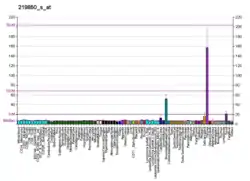ETS homologous factor is a protein that in humans is encoded by the EHF gene.[5][6] This gene encodes a protein that belongs to an ETS transcription factor subfamily characterized by epithelial-specific expression (ESEs). The encoded protein acts as a transcriptional repressor and may be associated with asthma susceptibility. This protein may be involved in epithelial differentiation and carcinogenesis.[6]
Further reading
Cangemi, R., Mensah, A., Albertini, V., Jain, A., Mello-Grand, M., Chiorino, G., Catapano, C.V. & Carbone, G.M. Reduced expression and tumor suppressor function of the ETS transcription factor ESE-3 in prostate cancer. Oncogene 27, 2877-2885 (2008).
Albino D, Longoni N, Curti L, Mello-Grand M, Pinton S, Civenni G, Thalmann G, D'Ambrosio G, Sarti M, Sessa F, Chiorino G, Catapano CV, Carbone GM. ESE3/EHF controls epithelial cell differentiation and its loss leads to prostate tumors with mesenchymal and stem-like features. Cancer Res. 2012 Jun 1;72(11):2889-900.
Kunderfranco, P., Mello-Grand, M., Cangemi, R., Pellini, S., Mensah, A., Albertini, V., Malek, A., Chiorino, G., Catapano, C.V. & Carbone, G.M. ETS transcription factors control transcription of EZH2 and epigenetic silencing of the tumor suppressor gene Nkx3.1 in prostate cancer. PLoS One 5, e10547 (2010).
References
- 1 2 3 GRCh38: Ensembl release 89: ENSG00000135373 - Ensembl, May 2017
- 1 2 3 GRCm38: Ensembl release 89: ENSMUSG00000012350 - Ensembl, May 2017
- ↑ "Human PubMed Reference:". National Center for Biotechnology Information, U.S. National Library of Medicine.
- ↑ "Mouse PubMed Reference:". National Center for Biotechnology Information, U.S. National Library of Medicine.
- ↑ Kleinbaum LA, Duggan C, Ferreira E, Coffey GP, Buttice G, Burton FH (Nov 1999). "Human chromosomal localization, tissue/tumor expression, and regulatory function of the ets family gene EHF". Biochem Biophys Res Commun. 264 (1): 119–26. doi:10.1006/bbrc.1999.1493. PMID 10527851.
- 1 2 "Entrez Gene: EHF ets homologous factor".
- Fujikawa M, Katagiri T, Tugores A, et al. (2007). "ESE-3, an Ets family transcription factor, is up-regulated in cellular senescence". Cancer Sci. 98 (9): 1468–75. doi:10.1111/j.1349-7006.2007.00543.x. PMID 17627613. S2CID 2539168.
- Ewing RM, Chu P, Elisma F, et al. (2007). "Large-scale mapping of human protein-protein interactions by mass spectrometry". Mol. Syst. Biol. 3 (1): 89. doi:10.1038/msb4100134. PMC 1847948. PMID 17353931.
- Park C, Lee I, Kang WK (2007). "Influence of small interfering RNA corresponding to ets homologous factor on senescence-associated modulation of prostate carcinogenesis". Mol. Cancer Ther. 5 (12): 3191–6. doi:10.1158/1535-7163.MCT-06-0570. PMID 17172423.
- Lim JH, Cho JY, Park YB, et al. (2006). "ESE-3 transcription factor is involved in the expression of death receptor (DR)-5 through putative Ets sites". Biochem. Biophys. Res. Commun. 350 (3): 736–41. doi:10.1016/j.bbrc.2006.09.102. PMID 17027647.
- Taylor TD, Noguchi H, Totoki Y, et al. (2006). "Human chromosome 11 DNA sequence and analysis including novel gene identification". Nature. 440 (7083): 497–500. Bibcode:2006Natur.440..497T. doi:10.1038/nature04632. PMID 16554811.
- Appel S, Bringmann A, Grünebach F, et al. (2006). "Epithelial-specific transcription factor ESE-3 is involved in the development of monocyte-derived DCs". Blood. 107 (8): 3265–70. doi:10.1182/blood-2005-06-2480. PMID 16380452.
- Gerhard DS, Wagner L, Feingold EA, et al. (2004). "The status, quality, and expansion of the NIH full-length cDNA project: the Mammalian Gene Collection (MGC)". Genome Res. 14 (10B): 2121–7. doi:10.1101/gr.2596504. PMC 528928. PMID 15489334.
- Strausberg RL, Feingold EA, Grouse LH, et al. (2003). "Generation and initial analysis of more than 15,000 full-length human and mouse cDNA sequences". Proc. Natl. Acad. Sci. U.S.A. 99 (26): 16899–903. Bibcode:2002PNAS...9916899M. doi:10.1073/pnas.242603899. PMC 139241. PMID 12477932.
- Silverman ES, Baron RM, Palmer LJ, et al. (2003). "Constitutive and cytokine-induced expression of the ETS transcription factor ESE-3 in the lung". Am. J. Respir. Cell Mol. Biol. 27 (6): 697–704. doi:10.1165/rcmb.2002-0011oc. PMID 12444029.
- Tugores A, Le J, Sorokina I, et al. (2001). "The epithelium-specific ETS protein EHF/ESE-3 is a context-dependent transcriptional repressor downstream of MAPK signaling cascades". J. Biol. Chem. 276 (23): 20397–406. doi:10.1074/jbc.M010930200. PMID 11259407.
- Dias Neto E, Correa RG, Verjovski-Almeida S, et al. (2000). "Shotgun sequencing of the human transcriptome with ORF expressed sequence tags". Proc. Natl. Acad. Sci. U.S.A. 97 (7): 3491–6. Bibcode:2000PNAS...97.3491D. doi:10.1073/pnas.97.7.3491. PMC 16267. PMID 10737800.
- Kas K, Finger E, Grall F, et al. (2000). "ESE-3, a novel member of an epithelium-specific ets transcription factor subfamily, demonstrates different target gene specificity from ESE-1". J. Biol. Chem. 275 (4): 2986–98. doi:10.1074/jbc.275.4.2986. PMID 10644770.
- Bonaldo MF, Lennon G, Soares MB (1997). "Normalization and subtraction: two approaches to facilitate gene discovery". Genome Res. 6 (9): 791–806. doi:10.1101/gr.6.9.791. PMID 8889548.
External links
- EHF+protein,+human at the U.S. National Library of Medicine Medical Subject Headings (MeSH)
This article incorporates text from the United States National Library of Medicine, which is in the public domain.




